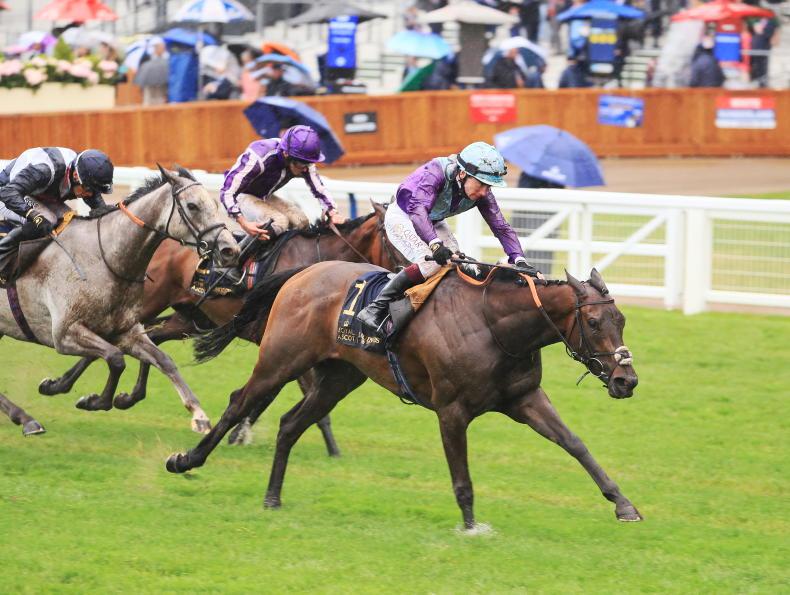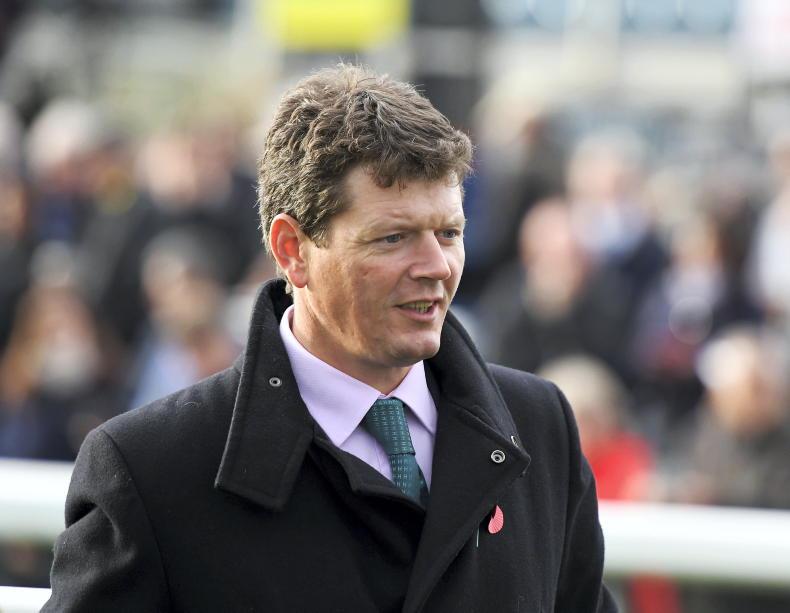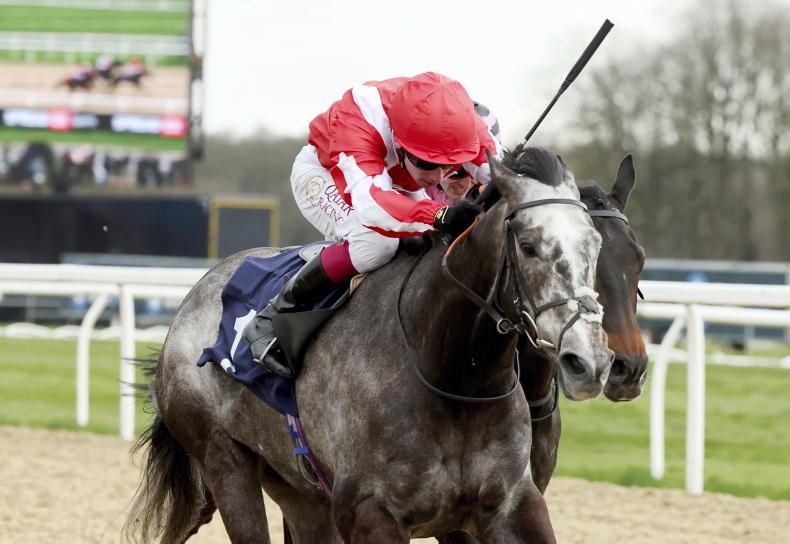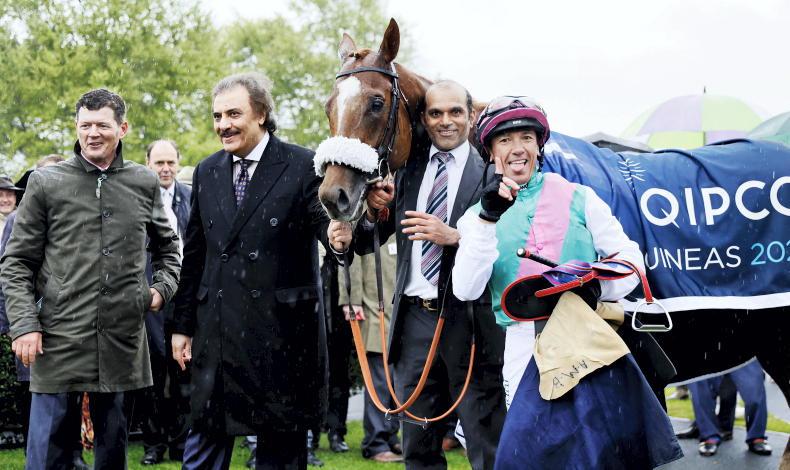Helen Sharp (HS): What’s the first thing you like to see when the string strides out in the morning?
Andrew Balding (AB): I’d like the first thing I see to be the horses relaxed, I hate seeing horses keen or sweating, I just like to see them enjoying their routine exercise. Work mornings are slightly different obviously because we are looking for different things with structural work, we are essentially trialing horses to see where they stand in terms of their ability. But at normal exercise, I like to see the horses relaxed and not pulling and not sweating too hard.

Certainly for trainers, horses that don’t want to go forward, we call it jibbing, you know there’s always an alarm bell if horses start doing that. Particularly when you have big strings - when everyone is here we’d probably have fifty at one lot, so it’s important, not that the horses conform as such, but that horses are happy and relaxed in a large string, and happy to do their routine exercise without showing signs of stress.
HS: If horses are jibbing, does that raise alarm bells for you in terms of their head or their body first?
AB: Body first, and if they do start showing unusual patterns of behaviour we’d always get the vet and chiropractors in and whoever else we can involve to check we are not missing a physical problem. If it is a mental problem we can change the routine and we are lucky here, we have other gallops and elsewhere they can exercise on their own. And obviously you know, we have a high-speed treadmill and swimming pool as well and turn out paddock. So we can play around with their training programme to a point to amuse them once we have eliminated the fact there might be a medical problem.
HS: What do you feel can be done to counteract soundness problems?
AB: I think soundness is a trainer’s biggest challenge, I mean the one thing and I think I speak for all trainers here, that we are trying to eliminate the best we can, is catastrophic injury. And that’s the one thing that every person who works here finds incredibly difficult to deal with is a catastrophic injury on the gallops. And you know, we do all sorts of things to try and eliminate that risk - we trot the horses and have vets watching them doing their warm-ups. We do routine jog-ups in the evening to try and monitor soundness at all stages. And if there is a pattern of a horse showing any sign of lameness obviously we have it investigated - diagnostics have so improved in the last twenty years since I started training.
Bone scans, magnetic resonance imaging (MRI) scans, we have portable x-ray machines now, everyone does. And you know that wasn’t the case when my Dad (Ian Balding, trainer of numerous equine stars such as Mill Reef and Lochsong) was training, it was very difficult to get instantaneous access to x-rays. We are spoiled in terms of the improvement in diagnostics.
But soundness is the challenge and keeping horses to be able to train them to an intensity that delivers results without compromising their soundness. That’s the art of training in many ways, it’s the challenge we all have and that’s the skill particularly with young horses, you are dealing with developing skeletons and developing bodies and you’ve got to be aware of that. That’s the challenge.

HS: What is your regime to build up those developing bodies? Do you have a fixed routine to build e.g. stamina or is it different for every horse?
AB: Some of them we are trying to avoid putting too much stamina into. I mean I’m talking about flat horses here because jumping is entirely different, but essentially we’ve got young horses that when they come into training we are trying to develop a programme that will allow them develop bone density at the same stage as educating them.Trying to develop their awareness of what’s required of them basically. So it’s just a fine line between an exercise regime that enhances bone development and doesn’t put them at risk, but also is taking their respiratory system, heart, developing that with an intensity of exercise that is developing fitness and a horse’s awareness of other horses around them and what’s required of them: settling, going through gaps, quickening, that type of thing.
There is a stage and each horse will hit that stage at different times depending on the type they are. So early season two-year-olds will be probably working in bunches as early as the end of February, very early March. Whereas some of the later developing middle distance horses probably won’t be at the stage of sitting up until later. Effectively it’s the same programme, but it will happen at different times or different stages depending on the capacity the horse is showing, or what we would expect from their pedigree. So it’s tailored to suit every horse. I’d like to think the training programmes we are trying to develop are tailored for each individual.
HS: What sort of approach do you take with horses showing a bit of resistance?
AB: I think there’s always a reason with horses. This is very different if a horse has run and shown some ability and develops into a character let’s say. You have the utmost patience and plenty of good horses here who need their own individual attention and training programme, have their own little idiosyncrasies. With a horse that hasn’t raced and who shows an attitude that is unwilling or uncooperative to a degree where he/she might be dangerous, I’m loathed to put any of my staff at risk.
Obviously we are conscious that if the horse is in any way unsafe it wouldn’t go to a sale without some sort of warning. But happily there are people in smaller yards who are prepared to take on a challenge and that’s often the case, that horses that we don’t feel are suitable for Kingsclere might be tried at a different environment and sometimes with success.
HS: How do you get inside the head of a thoroughbred?
AB: With young horses two and three-year-olds, I think generally speaking 98% of them want routine. They enjoy routine, they want to know when they are going to get fed, they want to know what they are going to do at exercise. If you start fiddling around with the routine of a young horse it doesn’t necessarily suit.
I think once the horses get to the age of four particularly geldings and fillies, not so much colts, the gelding and fillies probably appreciate a change in routine and a slightly different training programme. I think the young horses are quite easy to my mind anyway, lots of people do it in different ways but what I found is that they tend to be more settled and relaxed and happier in a routine. So whatever that routine might be, try and develop it and if you can develop a routine which maintains fitness, enhances bone development and it’s a daily routine the horses are comfortable in, that’s what we are looking to achieve. The minute you have to start trying to think about getting in their minds it’s because they are not fitting into your routine, if that makes sense. Which is sometimes the case and then you treat every horse on an individual basis.
But there are horses and last year is a typical example, I had a nice filly that just would not work for me, we tried all sorts of different things for her lovely owner. I suggested he moved her to try a different environment and she went and won first time out for Owen Burrows. Looks like she’ll be a very useful filly. I’m delighted for him, she just wasn’t happy here for some reason.

HS: Would you say there is such a thing in a thoroughbred as a winner’s mentality.
AB: Very much so. I think that’s absolutely key, it’s the one thing when you are going to yearling sales you can’t begin to legislate for. I mean you can see the old stockmen signs of an honest head, generous eye, and big ears as an indicator.
You get some idea when they walk and they put their head down and walk with a bit of purpose. But until you put them under the pressure of a race you never really know whether the desire is there. I think it’s absolutely key in any good horse that they have a will to win. That’s what they are trying to do essentially, we are trying to find the ultimate racehorse who wants to win more than the next one. But it’s essential.
HS: In terms of horsemanship, maybe it’s from your Dad or maybe it’s from somebody else, what is the most important lesson you’ve learnt?
AB: Oh, that’s a difficult question. The role of the trainer has changed so much in a yard our size: we have over two hundred horses. I mean I never ride, I haven’t ridden a horse for twenty five years. But I used to, so I had that, but I don’t have that much hands-on contact with them. I see them trot up every day and I feel their legs before they race. And at evening stables with the owners, I look at every individual horse with it’s rugs off once during the week and see them all out of exercise.
So my role is not so much a horsemanship role, but the one thing which I think anyone who is even vaguely in tune with horsemanship knows is you want to see a relaxed and happy horse.
HS: How does unhappiness manifest in a racehorse?
Appetite, to me that’s very important. The one thing I’m anxious to know in the morning is which horse has left any feed, I think that’s always a classic indicator of something not quite right - if they are leaving food.
HS: What do you feed?
AB: We keep it very simple, nuts and chaff. We do give a calcium supplement to the young horses in the hope it helps their bone development. And we also give electrolytes after work mornings and when it’s hot. But apart from that unless it’s prescribed by the vet in terms of antibiotics or something like that, we wouldn’t do anything else, no other supplements.
HS: How do you judge how fast a horse is going to go at peak? Do you never know until they are put under race pressure?
AB: You never know.
HS: So it only happens on the racecourse?
AB: Personally, I wouldn’t try and find that out until we get to the racecourse. So a lot of it is guessing, I mean some trainers are far more accurate you know, would work to better stride rate and percentages than we would.
But the science of training is so hugely improved. Now most trainers have access to GPS systems with a heart monitor in for your faster work and you can really get some very accurate data on what the horses have achieved.
So you get the visual impression by watching them, but then it can be backed up by all sorts of science which has helped.
I think when you are undecided and the data is put in front of you at the end of the morning and you realise that it was an exceptional piece of work, it means for example all three horses have gone really well because it’s backed up with the times they achieved.
This data is pretty accurate now you know, it’s pretty high-end stuff.

HS: Do you use heart monitors?
AB: Yeah, all that is incorporated in the system we use. We don’t have it on every horse, but we would if there was any question mark with a bit of routine exercise or faster work. We can pop the heart monitor on and it also measures stride lengths and the speed of each furlong.
HS: What can you do for a horse to help it once it comes off the track?
AB: Yeah funny enough, I was walking the dogs this afternoon and I was thinking exactly that. To me we get bogged down with this whip debate and things like that. That’s a moment in a horse’s life that they’ll never remember, and to me is not a welfare issue in any way shape or form. It’s an optic perception issue, in my opinion.
Far more relevant is the retraining of racehorses, you know, what happens to racehorses after they finish their racing career and I think we have all got an obligation to have a conscience and to put that at the top of the agenda rather than getting blindsided by whip debates etc.
But if we can put our hand on our heart and say that we offer British racing the best aftercare for horses once they finish the entertainment side of things, then I think we can stand proud. I think it is hugely important for all of us to have a conscience about that.
The trouble is it’s a commercial operation, it’s an industry and we do sell horses and we have no way of knowing what country or what jurisdiction, where or how they are going to end up once they leave this country. But I think we could just start by saying that the horses that finish their racing career in England, that we all have an obligation to make sure that they are, not all are suitable for retraining of course, but that they get the opportunity to have a life after racing.
HS: I feel trainers get a bit of a hard time on the re-homing front when perhaps it should be the owner’s responsibility?
AB: Yeah, it shouldn’t just be all on the trainers, I think there should be a mandatory addition to the licence of a registration of every horse that contributes to a central fund that then ensures their welfare, and there are mechanisms like that in progress. It’s something we’ve all got to support and have a conscience for.
HS: Is British racing getting a rough ride at the minute do you think?
AB: Well, I think we are absolutely great at self-harm. I mean we can’t wait to do ourselves down. It’s absolutely ridiculous. I think there are some very positive moves on the horizon. It’s not helped that the rest of the world and the country is probably at an all-time low for my lifetime anyway. For the last 30 years anyway, which isn’t helpful.
We’ve got a gambling review which is significant and impacts British racing but I think there are all sorts of things we can do to help ourselves. And you know, hopefully there are some moves happening as we speak that are going to give us the opportunity to maintain the sport’s position as being relevant.
The biggest problem we’ve got was racecourse attendance dived a bit last year, but that was hardly surprising given the economic situation of so many people. But it would be nice to think that we can try and develop the sport to give it back its centre of attention within the sports’ editors of the main newspapers, because you know the Times have dropped it, as have a couple of the other national newspapers. That is important that we get media exposure, that they enjoy it. Thirty years ago it was far more prominent within the sports pages of your standard newspapers.
HS: I think a documentary like the Horse Power one you did is so positive for racing across the board.
AB: Yeah it was beautifully produced and well-filmed and the feedback has been amazing. Much more from people with nothing to do with racing, you wouldn’t believe how many people would stop us and say they really enjoyed it, because it does give a little bit of an introduction to people who don’t necessarily know a lot about racing.
HS: Is there anything else that you want to say about horsemanship or training?
AB: The only thing is, I just think there are so many different ways of doing it, so many different approaches and no one is right and no one is wrong. I mean the results speak for themselves you know; unhappy horses don’t win races. I think people who have plenty of winners can’t be doing too much wrong, however which way they do it, they are all different. There will be people who think I’m talking a load of bollocks but there we go!




 This is a subscriber-only article
This is a subscriber-only article
 It looks like you're browsing in private mode
It looks like you're browsing in private mode








SHARING OPTIONS: